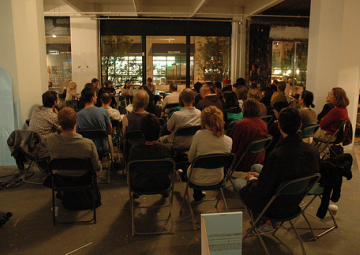
Every two years, the Triangle Arts Association organizes a workshop that welcomes dozens of artists from around the world for the Triangle Workshop. Participating artists are offered free room and board while they work in a communal studio space, usually a subdivided floor of a large industrial or commercial building, which allows them to work freely and collaborate. This year’s workshop kicked off on September 14.
Begun in 1982 by British sculptor Anthony Caro and London-based collector and businessman Robert Loder, the Workshop culminates in a dynamic Open Studios event that this year falls on Saturday, September 27. I should mention that I am honored to have been asked to join the board of Triangle this year.
One of the workshop events that people often look forward to during Triangle is the panel discussion. This year’s panelists were: Thomas Butter, sculptor and painter who teaches at Parsons and Brooklyn College; Nora Herting, an artist who works with photography, alumna of 2006 Triangle Workshop, and recent recipient of a grant from the Brooklyn Historical Society for a project that will involve portraits of people of Brooklyn; Ethan Kruszka, artist from St Paul, MN, member of the Fluff Artists’ Collective participant in Triangle 2008; Andrea Liu, art critic who writes for Art US, fellow at the New Museum Night School (I think that’s what she said, but you better check); and Karen Wilkin (moderator), critic/curator and board member of Triangle Arts Association. The topic of the panel was “Eternity?: Do you imagine your art as lasting into perpetuity or do you make it to exist only for its time?“ I’ll try to give you a sense of what the panel was about.
I attempted a novel way of following the event, namely Twittering (or tweeting) the panel to allow my first reactions to be broadcast unfiltered by reflection (which I hope I don’t regret). It worked fine but I felt very anti-social as I continuously typed into a three inch screen–eventually I gave up.
The discussion started when the artists on the panel were asked whether they think about the longevity of their work as they create. Nora Herting explained that as a photographer she is more aware of time because of her medium (which Wilkin rightfully pointed out “stops time”) but she doesn’t feel self-conscious about longevity. Butter, who is known to use unorthodox materials in his art, had an insightful anecdote about Michaelanglo’s David (1501-4) which he said was iconographically rooted in the politics of its time but today continues to inspire us today because of its emotional impact and the clarity of its language.
Critic Andrea Liu wondered if the notion of longevity wasn’t a white male issue [though I’d argue the ancient Egyptians and their pyramids disproves the notion that longevity is a white issue]. She clarified that there hasn’t been a line of art produced by women to suggest that longevity is of interest to female artists. She also discussed the impact of the 1980s art boom and how many of these people have not lasted in terms of their reputation or market (Julian Schnabel being the most obvious example).
Artist Ethan Kruszka argued that growing up in the 1980s generation the idea of permanence seemed anathema during that materialistic age that was dominated by junk bonds and consumerism. Everything feels disposable, he said and he even wondered if any artist created work that is meant to last anymore–Herting quickly pointed out that Jeff Koons is an example of a contemporary artist “practically making pyramids” in our own age.
The dialogue was dominated by discussions of modernism and postmodernism, suggesting that there was a divide in perspective that revolved around people’s notions about the role of art.
After the panel I asked the moderator, Karen Wilkin, to explain what she thought was the takeaway from the evening’s discussion: “For me, the panel underscored the apparently unbridgeable gulf between those who believe that the physical, formal, and material qualities of works of art are essential components in conveying emotion and meaning and those whose fundamental assumption is, as Ethan Kruszka said, that ‘Ideas last. Objects are expendable.'”
Monday: Touring Triangle Open Studios & the DUMBO “Art Under the Bridge” Festival